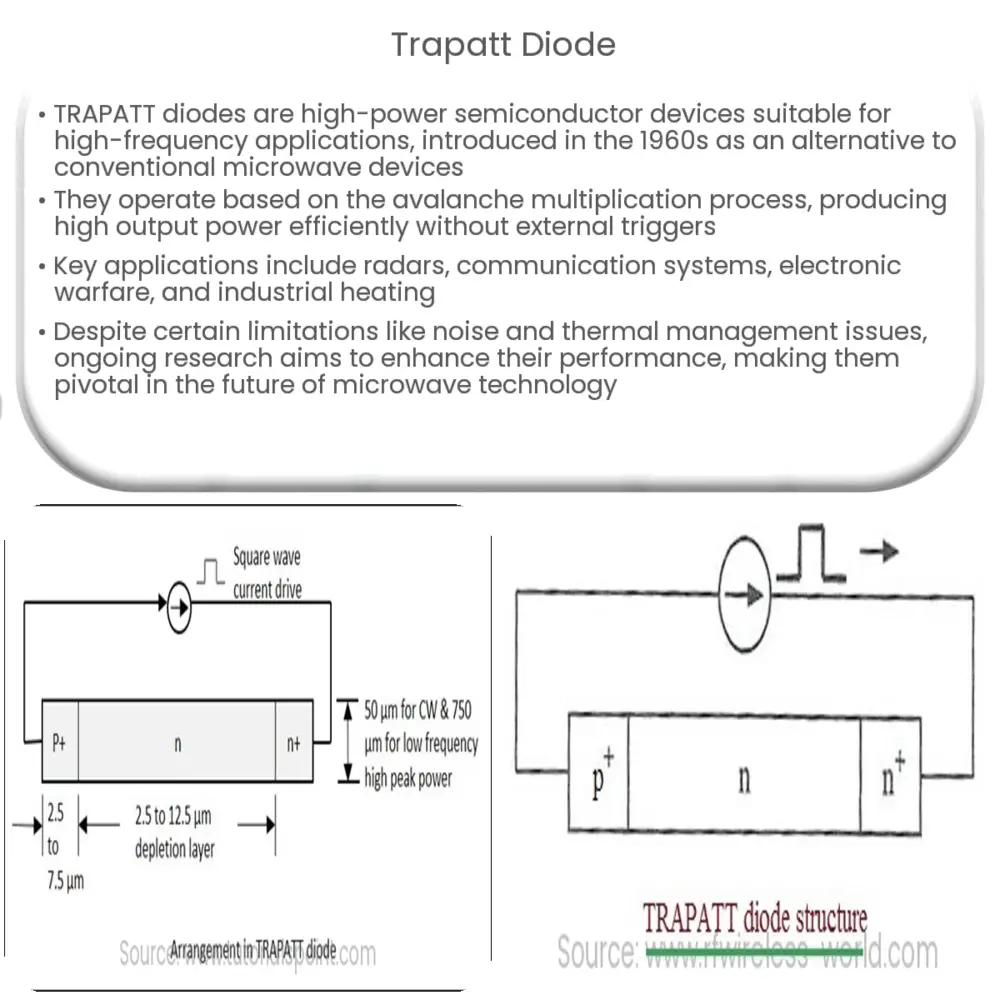The TRAPATT diode is a high-power semiconductor device used in microwave applications, known for its high efficiency and compact size.

TRAPATT Diode: Introduction and Applications
Introduction
A TRAPATT (Trapped Plasma Avalanche Triggered Transit) diode is a high-power semiconductor device that operates in the microwave frequency range. It was first introduced in the 1960s as a cost-effective alternative to conventional microwave devices, such as klystrons and magnetrons. The TRAPATT diode is particularly suitable for use in high-frequency, high-power applications due to its unique avalanche process and ability to generate high output power with high efficiency.
Working Principle
The TRAPATT diode operates on the principle of the avalanche multiplication process, in which an electric field accelerates charge carriers (electrons and holes) across the p-n junction, creating a high-current, high-voltage pulse. The main feature of the TRAPATT diode is that it operates in a self-sustained mode, without the need for external triggering or synchronization. This is achieved through a process called ‘trapped plasma,’ wherein the charge carriers become trapped in the high-field region of the diode, leading to the generation of oscillatory current and voltage waveforms.
When a reverse voltage is applied to the TRAPATT diode, the electric field across the junction causes charge carriers to accelerate and undergo impact ionization, which in turn generates more carriers through the avalanche multiplication process. This creates a dense space charge region, which eventually collapses under the influence of the applied electric field. The sudden collapse of the space charge region generates a rapid current pulse, which propagates through the diode and produces a high-power microwave output signal.
Applications
Due to their unique combination of high output power and high efficiency, TRAPATT diodes have found widespread applications in various microwave systems, including:
- Radars: TRAPATT diodes are used in pulse radar systems for generating high-power microwave pulses. The diode’s ability to produce high output power with low input power requirements makes it an attractive choice for radar applications.
- Communication systems: In satellite communication systems, TRAPATT diodes are used as high-power microwave oscillators for uplink and downlink transmissions. The diode’s high efficiency and power handling capabilities enable the development of compact and power-efficient communication systems.
- Electronic warfare: TRAPATT diodes are utilized in electronic warfare systems for generating high-power microwave signals used in jamming and deception operations. The diode’s high output power and frequency agility make it suitable for these applications.
- Industrial heating and welding: TRAPATT diodes can be used in industrial microwave heating systems, where their high-power output is employed for rapid and uniform heating of materials.
In summary, TRAPATT diodes offer a unique combination of high output power and high efficiency, making them an attractive choice for various high-frequency, high-power applications. Their working principle and applications showcase their potential in shaping the future of microwave technology.
Advantages and Disadvantages
TRAPATT diodes offer several advantages over conventional microwave devices, including:
- High output power: TRAPATT diodes can generate high output power levels, typically in the range of several hundred watts to several kilowatts, depending on the device configuration and operating conditions.
- High efficiency: The avalanche multiplication process in TRAPATT diodes allows for high conversion efficiency, often exceeding 50%, which is significantly higher than that of other semiconductor microwave devices.
- Compact size: Due to their semiconductor nature, TRAPATT diodes are inherently smaller and lighter than vacuum tube-based microwave devices, leading to more compact and portable systems.
- Low cost: The fabrication of TRAPATT diodes is compatible with standard semiconductor manufacturing processes, enabling cost-effective mass production.
However, TRAPATT diodes also have some limitations and drawbacks:
- Noise: The avalanche multiplication process in TRAPATT diodes can generate high levels of noise, which may limit their use in certain applications requiring low-noise performance.
- Thermal management: High output power and efficiency can lead to significant heat generation, requiring careful thermal management to maintain reliable operation and prevent device failure.
- Narrow frequency range: TRAPATT diodes typically operate within a relatively narrow frequency range, which can limit their versatility in some applications.
Future Prospects
Despite some limitations, the potential of TRAPATT diodes in various high-power microwave applications remains significant. Research and development efforts are focused on improving their performance and addressing their drawbacks. Some areas of ongoing research include:
- Noise reduction: Developing new device structures and materials to reduce noise levels and improve overall performance.
- Thermal management: Investigating advanced cooling techniques and materials to enhance heat dissipation and maintain stable operation.
- Frequency agility: Exploring novel device designs and fabrication methods to enable broader frequency coverage and enhance the versatility of TRAPATT diodes.
As microwave technology continues to evolve, TRAPATT diodes are expected to play an increasingly important role in the development of advanced radar, communication, and electronic warfare systems. Their high output power, efficiency, and compact size make them an attractive choice for a wide range of applications, and ongoing research is poised to further expand their capabilities and potential uses.
Conclusion
TRAPATT diodes have emerged as a promising alternative to conventional microwave devices, offering a unique combination of high output power and efficiency in a compact form factor. Their wide range of applications, from radar systems to industrial heating, demonstrates their versatility and potential to shape the future of microwave technology. While there are challenges to overcome, ongoing research and development efforts are expected to improve the performance and capabilities of TRAPATT diodes, further solidifying their position as a key component in high-power, high-frequency applications.



